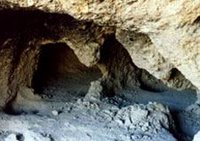Two Ancient Caves Discovered in Qasr-e Shirin

Tehran, 16 February 2006 (CHN) -- Archeological excavations in the city of Qasr-e Shirin resulted in the discovery of two caves belonging to the Neolithic era and the Middle Elamite period.
“Two caves were discovered in the southern foothills of Bazidar Mountains, one of them dates back to some 9000 years ago during the Neolithic era, and the other belongs to the Middle Elamite period and contemporary to the Iron Age in Zagross and Central Plateau of Iran. A large number of stone tools have also been discovered in a small cave during the excavations. The depth and the opening of this cave are both 6 meters and it seems that it was used as a shelter by the inhabitants of the region. During Iran-Iraq war this cave was used by Iraqi soldiers as bulwark and now the local nomads use this cave to keep their cattle in it,” said Ali Hajbari, head of excavation team in Qasr-e Shirin.
Prior to this, archeological excavations in the city of Qasr-e Shirin led to the discovery of the defensive wall of Khosrow Parviz Castle and 35 other historical sites. 40 kilometers of this wall is located inside Iran and the rest of it continues in Iraq’s soil. Archeologists believe that Khosrow Parviz, the Sassanid King, constructed this shell-keep to protect his beloved, Shirin.
The 35 discovered historical sites belong to the Neolithic era (6500 BC) and Chalcolithic period (5000-3000 BC) relating to the middle and new Elamite and Achaemenid periods.
Moreover, archeological excavations at the historical site of Qasr-e Shirin resulted in the discovery of some clays belonging to the Uruk period (Mesopotamia civilization) and special kinds of clays belonging to the beginning of written language.

0 Comments:
Post a Comment
<< Home